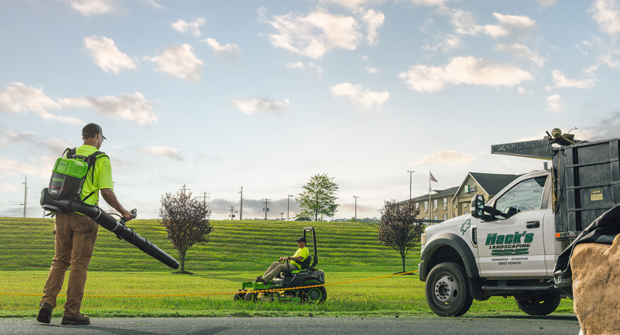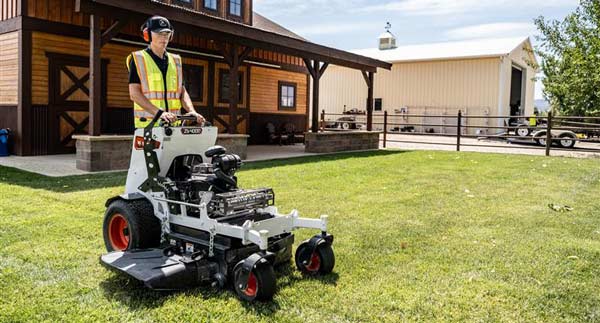While battery-powered handheld landscape equipment has existed for decades, recent technological advancements have transformed it into a viable and often superior alternative to gas-powered models. Despite this evolution, persistent myths challenge its adoption as a practical choice for landscape and lawn care professionals.
Greenworks product experts helped debunk five popular myths surrounding battery-powered landscape equipment.
Myth #1: No oomph
A common misconception is that battery-powered equipment lacks the power to handle professional jobs. While this may have been true in the past, significant advancements in lithium-ion battery technology have rectified this issue.
Anthony Marchese, senior vice president of sales and operations for the commercial business group at Greenworks, believes this myth persists because early battery equipment lacked the power to match gas tools without a noticeable drop in performance. However, advancements in battery technology enabled the creation of Greenworks’ 82-volt platform, which delivers gas-like power and runtimes. This created a new category of powerful battery equipment that is now seeing widespread adoption, he says.
“We’ve recently seen another big step forward in the new core battery technology, which has allowed us to make a product that is as powerful as gas, but more powerful at an equal or lesser weight,” Marchese says. “So, the transition from gas to battery is beginning to happen rapidly.”
Myth #2: Won’t go the distance
The idea that battery-powered equipment can’t last a full workday is a complex misconception, Marchese says. Early on, landscape crews saw managing nearly two-dozen batteries to match the performance of a gas-powered unit as unrealistic, expensive and logistically impractical.
However, Marchese says Greenworks recognized that a single solution wouldn’t fit every landscape crew. So, its engineers developed a variety of charging solutions to ensure professionals have continuous power without disrupting crew workflow.
One key innovation is the EnergyCube, a 16.2-kilowatt power source that mounts on a trailer. Using charging caddies, crews can recharge batteries throughout the day. This approach provides a constant supply of power, reduces the number of batteries needed, and extends their lifespan by preventing constant, heavy-duty cycling.
Additionally, mowing crews can utilize Greenworks’ 24-kilowatt Optimus zero-turn mower to recharge handheld batteries while on the job via an externally mounted charging caddy. This DC-to-DC charging capitalizes on the often 30-40 percent remaining battery life in the mowers at the end of the day.
By offering a variety of charging options, Greenworks ensures contractors start their day with a full charge, work without interruption and easily recharge at the end of the day, eliminating the need for constant gas station stops.
“Multiple solutions to power multiple different customers,” Marchese says. “The myth that you don’t have enough power to get through the day is just not true anymore.”
Myth #3: It’s unreliable
A belief that professional-grade battery-powered equipment is less durable than its gas-powered counterparts couldn’t be further from the truth, says Nick Jiannas, Greenworks’ vice president, commercial sales.
Gas engines are inherently less durable due to their numerous moving parts, Jiannas says. Internal components — such as pistons, cylinders, crankshafts, and carburetors — are prone to wear and tear, requiring frequent maintenance and eventual replacement. Furthermore, ethanol in modern gasoline degrades rubber components like fuel lines and manifolds, leading to additional upkeep and potential in-field failures.
In contrast, Jiannas says battery-powered equipment is simpler by design -— a motor, a circuit board and a battery. This lack of complex mechanical systems means significantly less wear and tear, along with little to no maintenance.
“Every spring, a landscape pro needs to have their gas-powered equipment tuned up,” Jiannas says. “You need a new fuel filter, air filter, maybe a new carburetor and on and on. With battery-powered equipment, you don’t have that. So in terms of longevity and maintenance, hands down battery-powered equipment is the way to go.”
Myth #4: Expensive
The belief that professional-grade battery-powered equipment is cost-prohibitive compared to a gas-powered equivalent is common. However, Jiannas says a cost-benefit analysis paints a much different picture. While the initial purchase price is slightly higher than for gas models, this upfront cost is quickly offset by substantial long-term savings. According to Jiannas, the return on investment (ROI) becomes clear when considering ongoing operational expenses.
For example, landscape pros using gas-powered equipment face significant and recurring costs for fuel and maintenance. A single zero-turn mower can easily consume five-to-eight gallons of gas per day. This expense adds up quickly, becoming a drain on a company’s finances. In addition to fuel, there are constant maintenance costs for components like fuel filters, air filters, belts, and engine tune-ups.
In contrast, battery equipment eliminates fuel costs and requires virtually no maintenance due to its lack of complex moving parts.
“A shrewd business owner will realize they’re spending a little more upfront, but battery-powered equipment is going to last them a long time,” Jiannas says. “They’ll see the equipment pay for itself in less than two years. After that, it’s all gravy. So, while there is a slight upfront cost difference, the ROI is there.”
Myth #5: Battery management is a hassle
Managing battery logistics is a common concern among contractors considering a switch to battery-powered equipment. However, both Jiannas and Marchese agree there is a learning curve, and it’s far from the hassle it’s often perceived to be.
The key, they say, lies in customized charging solutions that eliminate the need for an excessive number of batteries. Crew leaders and business owners must assess their specific energy needs based on daily tasks, whether it’s mowing, hedge trimming or blowing leaves. This determines the correct combination of batteries and charging solutions a crew needs to complete its job and return to the shop for overnight charging.
According to Jiannas, landscapers don’t need to buy numerous batteries. For example, a landscaper could buy fewer batteries and use a rapid charger to keep them in rotation. In many cases, Jiannas says a battery can be recharged faster than it’s depleted. This means that if a user is charging one battery while using another, they can have a continuous power supply without needing a large, expensive fleet of spares.
Marchese adds a key advantage of battery-powered equipment is its smart, data-driven intelligence. Unlike traditional gas engines, which offer no operational insights, many of Greenworks’ large products, such as zero-turns and utility vehicles, are equipped with a 4G connection. This connectivity allows contractors to track a unit’s location, monitor its performance and even remotely disable it if stolen.
Beyond location tracking, this technology provides vital battery health data by tracking the number of charge cycles. According to Marchese, this information helps landscapers proactively manage their battery fleet, allowing them to predict when batteries will need to be replaced and to budget accordingly. By turning what was once a guessing game into a predictable business operation, this technology makes the transition to battery power a smart financial decision.
“Battery management is really at your fingertips,” Marchese says. “How many batteries in my fleet will I need to replace in the fiscal year coming up? We can offer that kind of information to contractors, and they can make it part of their routine maintenance.”
Mike Zawacki is a Cleveland-based journalist and frequent LM contributor who has covered various aspects of the green, horticultural, sports turf, and irrigation industries for the last 20 years.


